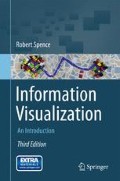Abstract
Establishes, by considering a variety of activities, the issues that must be addressed in order to understand and make effective use of visualization. It ends with the proposal of a model of the visualization process whose major components are Representation, Presentation and Interaction.
Access this chapter
Tax calculation will be finalised at checkout
Purchases are for personal use only
Notes
- 1.
The median is much more useful than the mean, because one false data observation can seriously throw off the mean, whereas the median is not affected until half the data observations are false. In other words, the median is a much more robust measure.
- 2.
Also referred to as a cognitive map (Tversky 1993).
- 3.
The concept of sensitivity has very wide relevance, and will be a recurring theme of this book.
References
Cleveland S, Becker RA, Weil G (1988) The use of brushing and rotation for data analysis. In: Proceedings IASC world conference on computational statistics and data analysis, International Statistical Institute, Voorburg, pp 114–147
Havre S, Hetzler E, Whitney P, Nowell L (2002) ThemeRiver: visualizing thematic changes in large document collections. IEEE Trans Vis Comput Graph 8(1):9–20
Hintze JL, Nelson RD (1998) Violin plots: a box plot-density trace synergism. Am Stat 52(2):181–184
Nielsen J, Tahir M (2002) Homepage usability. New Riders, Indianapolis
Schon DA (1983) The reflective practitioner: how professionals think in action. Basic Books, New York
Tversky B (1993) Cognitive maps, cognitive collages and spatial mental models, in ‘Spatial information theory – a theoretical basis for GIS’. In: Proceedings of the European conference COSIT’93. Lecture notes on computer science 716. Springer, Berlin/Heidelberg, pp 14–24
Ware C (2012) Information visualization: perception for design, 3rd edn. Morgan Kaufman, Amsterdam
Wittenburg K, Lanning T, Heinrichs M, Stanton M (2001) Parallel bargrams for consumer-based information exploration and choice. In: ACM, proceedings of UIST’01, pp 51–60
Author information
Authors and Affiliations
Exercises
Exercises
2.1.1 Exercise 2.1
What are the drawbacks and advantages of the bargram representation of data?
2.1.2 Exercise 2.2
A car is described by a number of attributes: price, appearance, make, recommendations, horse-power, year of manufacture and age. Say which of these attributes are numerical, ordinal or categorical.
2.1.3 Exercise 2.3
Based on your experience of buying a mobile phone, washing machine, bicycle, car or other multi-attribute object, express your view as to the meaning of the term ‘overview’ and ‘detail’ and give some examples.
2.1.4 Exercise 2.4
For which of the attributes mentioned in Exercise 2.2 would it be possible to order the objects above the corresponding bar of a bargram?
Rights and permissions
Copyright information
© 2014 Springer International Publishing Switzerland
About this chapter
Cite this chapter
Spence, R. (2014). Issues. In: Information Visualization. Springer, Cham. https://doi.org/10.1007/978-3-319-07341-5_2
Download citation
DOI: https://doi.org/10.1007/978-3-319-07341-5_2
Published:
Publisher Name: Springer, Cham
Print ISBN: 978-3-319-07340-8
Online ISBN: 978-3-319-07341-5
eBook Packages: Computer ScienceComputer Science (R0)

